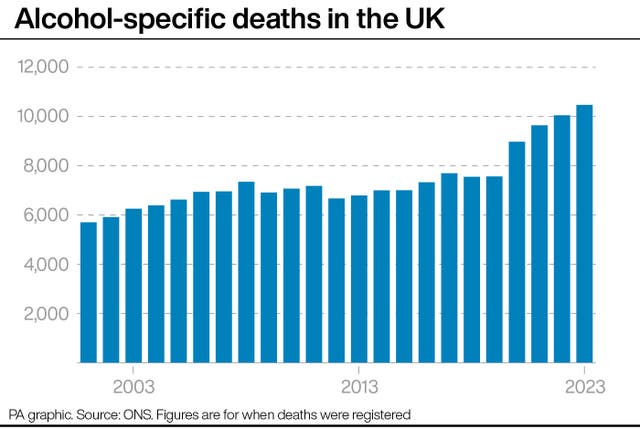Number of UK deaths specifically caused by alcohol reaches new record high
It is the fourth year in a row a new record has been reported by the Office for National Statistics.

The number of deaths across the UK specifically caused by alcohol has reached a record high, according to new figures.
It is the fourth consecutive year a new record has been reported by the Office for National Statistics (ONS).
Experts called for measures such as minimum unit pricing, health warnings on labels and tighter advertising regulations to be brought in to tackle the “growing health crisis”.
Some 10,473 deaths from alcohol-specific causes were registered in the UK in 2023.
These are deaths where health conditions are a direct consequence of alcohol, such as alcoholic liver disease.

The 2023 figure is 4% higher than the 10,048 registered in 2022 and up 38% on the 2019 total.
While the number of deaths increased, the rate fell slightly to 15.9 deaths per 100,000 people from 16.6 per 100,000 a year earlier.
The rate of deaths in males (21.9 per 100,000) remained around double that in females (10.3 per 100,000) in 2023.
Age-specific death rates fell for the first time since 2020 for people between the ages of 25 and 59, the ONS said.
Death rates for those aged 20 to 24 and over 60 remained the similar to 2022.
In England and Wales, death rates increased between 2022 and 2023 to 15.0 and 17.7 per 100,000 people.
The English region with the highest rate – 25.7 deaths per 100,000 – was the North East, while the East Midlands was the lowest at 11.5 deaths per 100,000.
Professor Sir Ian Gilmore, chairman of the Alcohol Health Alliance, said: “The drivers of this crisis are well known — cheap, easily accessible alcohol and aggressive marketing that normalises excessive drinking — as are the solutions proven to reduce harm.
“Measures such as minimum unit pricing, improved advertising regulations, mandatory health warnings on labels, and better investment in alcohol treatment services must be implemented across all UK nations without delay.”
Minimum unit pricing was introduced in Scotland in 2018 and means alcohol such as beer, wine and vodka can not be sold for less than that 65p per unit.
Sir Ian added that tackling alcohol harm “must be central” to the Government’s ambition of putting more focus on sickness prevention.
“Just as we have seen strong political will to tackle the harms caused by tobacco, junk food and gambling, we must apply the same urgency and commitment to reducing alcohol harm,” he said.
“Without meaningful intervention, these figures will continue to rise, and more lives will be lost.”
Ash Singleton, director of research and public affairs at Alcohol Change UK, added: “The tragically high number of alcohol-specific deaths, and the thousands more not reflected in this data where alcohol is a contributing factor, are not a coincidence, but a direct result of years of government inaction to tackle this harm to save and improve lives.
“The number of people drinking at hazardous and harmful levels, that is over the chief medical officers’ low risk drinking guidelines of 14 units a week, increases year on year.
“To prevent these figures rising further, policymakers must get serious about alcohol harm by focusing on prevention.”
Clare Taylor, chief operating officer at Turning Point, warned the “continued high level of alcohol deaths is a public health crisis”.
“Alcohol related deaths are preventable, and access to treatment remains the key protective factor,” she added.
“While numbers in treatment have increased significantly, too many are not getting the support they need early enough and there is still a great deal of stigma associated with alcohol problems.
“Preventing alcohol harm needs to be a national policy priority.
“We need better education and training for healthcare professionals working in GP surgeries, A&E departments and on hospital wards, and better joint working with community drug and alcohol services.”
Commenting on the figures, Pamela Healy, chief executive of the British Liver Trust, said: “Unfortunately these figures aren’t surprising.
“We are living in the shadow of harmful and hazardous drinking that is only increasing since the pandemic, and these latest figures highlight the terrifying scale of this growing health crisis.”
Dr Katherine Severi, chief executive of the Institute of Alcohol Studies, said: “We’ve seen record-high deaths from alcohol in the UK every single year since the pandemic.
“This simply cannot become the new normal, so the Government must make tackling alcohol harm a top priority in 2025.”
Scotland and Northern Ireland continued to have the highest death rate in the UK, the ONS said.
While Scotland’s death rate remained stable at 22.6 in 2023, the rate in Northern Ireland decreased to 18.5 per 100,000 people.
Laura Mahon, deputy chief executive of Alcohol Focus Scotland, said the figures demonstrate “that Scotland and the rest of the UK is firmly in the grip of an alcohol health emergency”.
“The truth is that a majority of these deaths, mostly caused by liver disease, come as a result of people drinking heavily over the course of many years – with one in five Scots drinking at a level which could be harmful to their health, including increasing their risk of liver disease and cancer,” she added.
“Unfortunately, the Covid pandemic exacerbated drinking patterns and we saw those who were already drinking heavily increase their consumption.
“The industry seeks to keep people in the dark about the health harms of alcohol by failing to provide us with the clear information we need to be able to make informed choices about our health.”





